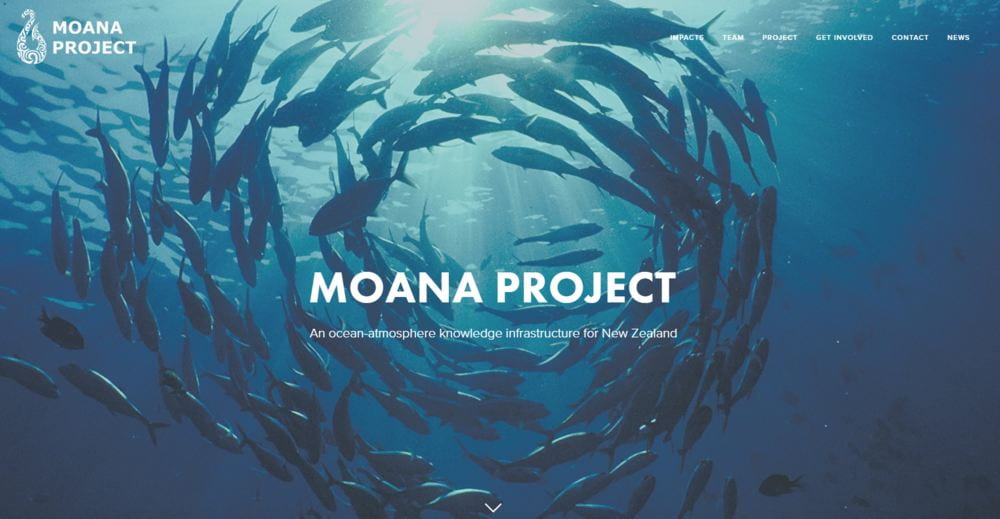In response to a rapidly changing ocean impacted by marine temperature extremes and shifting currents, a new ocean monitoring and forecast programme is underway in Aotearoa New Zealand. The Moana Project is in its early stages and aims to increase understanding of how the marine environment is changing by improving local knowledge about coastal ocean circulation connectivity and marine heatwaves. This information will help Aotearoa New Zealand’s seafood sector prepare for imminent changes and be more responsive in a changing environment, which will help the industry retain its competitive edge.
Who collects the data?
The seafood industry is at the heart of the system, with fishing communities gathering the data, with no cost or ongoing actions required of them. Fishing vessels are equipped with low-cost temperature sensors that collect data as the fishers go about their normal practices. These sensors, designed specifically for fishing gear and to handle rough conditions, are made in Aotearoa New Zealand by local company ZebraTech. In theory, these could be deployed ‘on all vessels, at all times’. The resulting data is much more fine-scale than what is captured via international models allowing for more detailed resolution, at around 5 km² blocks rather than 10 km².
The seafood industry is at the heart of the system, with fishing communities gathering the data, with no cost or ongoing actions required of them.
It is not only the quantitative scientific data captured by these sensors that informs the project. Transdisciplinary methods from kaupapa Māori research and social sciences are also used. The Moana Project draws on mātauranga Māori held by the local Eastern Bay of Plenty iwi, Whakatōhea. The iwi has local knowledge about the land and the sea from around 900 years in the area.

A temperature sensor used in the Moana Project. Image credit: 2018 MetOcean Solutions/ Meteorological Service of New Zealand (CC BY-NC-SA 4.0).
The Moana Project draws on mātauranga Māori held by the local Eastern Bay of Plenty iwi, Whakatōhea. The iwi has local knowledge about the land and the sea from around 900 years in the area.
How is it processed?
The sensors are connected to the internet and when transported aboard the data is automatically offloaded to data storage on-board and then uploaded to a cloud server. From there the data is transferred to a secure MetService database to be integrated into the newly developed ocean circulation models. Work is underway to determine the best modelling system to use locally.[1] The oceanographic knowledge gained from sensor data is triangulated with knowledge from te ao Māori.
Who can access it?
A key feature of the Moana Project is that the forecast system is open access and user friendly, meaning that industry can act on the information their data has informed. The datasets and tools to analyse it are also open access, though other information about vessel and catch will remain confidential.
How does it feed into management decisions?
For Whakatōhea, the plan is to use the new technologies to inform an ocean knowledge exchange platform that supports marine spatial planning and impact assessments to inform iwi governance of multi-sector activities in their rohe moana. Collaboration and involvement of the Ministry for Primary Industries in the process helps to support this new knowledge to inform regional marine policy and management.
What are the project’s strengths?
- Cross-disciplinary joint research teams that include people from the community as well as scientists allow for two-way knowledge sharing as well as co-designing the project.[2]
- Cross-cultural exchange of mātauranga and western science.[2]
- Collaborative approach between researchers, industry, iwi, central and local government, and international experts.[2] Uptake and participation by interest groups is incredibly important in the success of using new technologies for ocean monitoring.[2]
- Cost-effective approach that reduces costs by using an existing network of fishing vessels that are already out in the ocean, making data collection possible where it may have been cost-prohibitive otherwise.
- Accessible information so that fishers and others can act on the new data that comes to light and be responsive to a changing environment.
Improved local knowledge about ocean circulation will help grow our understanding of the changing marine environment, which will in turn be useful to inform responses to changing fisheries. The Moana Project highlights how new approaches to data collection may be able to support sustainability in commercial fisheries. The approach provides an exemplar for future-focused innovative data collection methods to inform a responsive fisheries management system.
References and footnotes
[1] Azevedo C. et al. (2020) Evaluation of four global ocean reanalysis products for New Zealand waters – A guide for regional ocean modelling, New Zealand Journal of Marine and Freshwater Research, pp. 1–24.
[2] Kaiser, B. A. et al. (2019) The importance of connected ocean monitoring knowledge systems and communities, Frontiers in Marine Science, 6, pp. 1–17.

